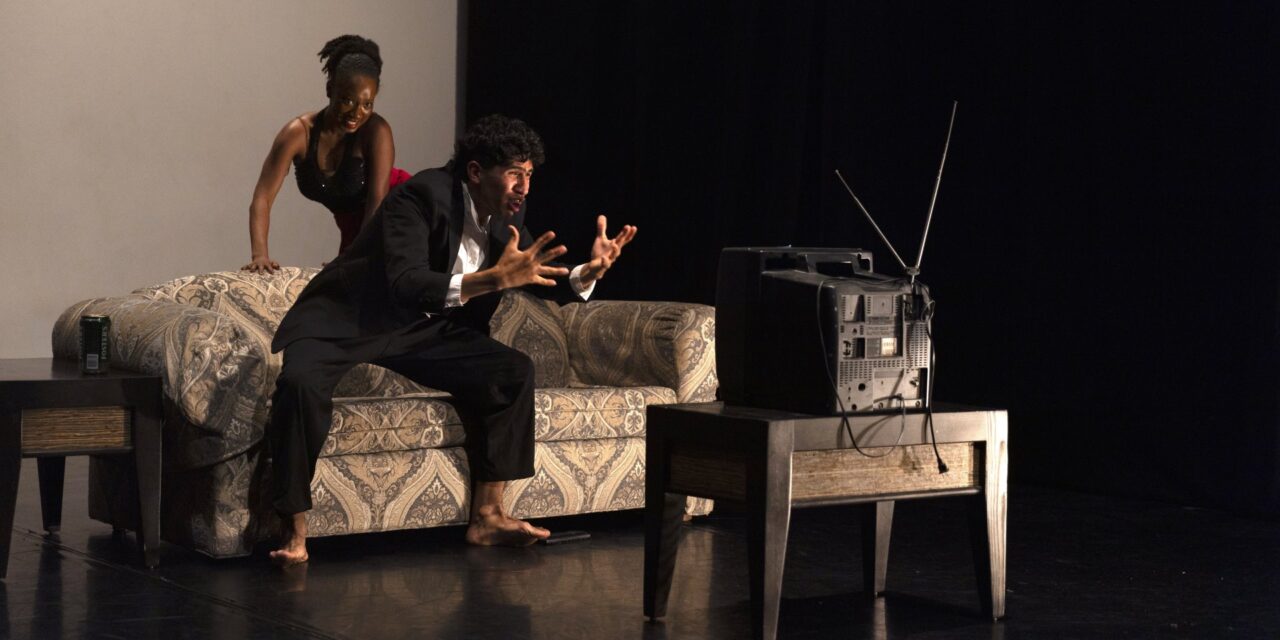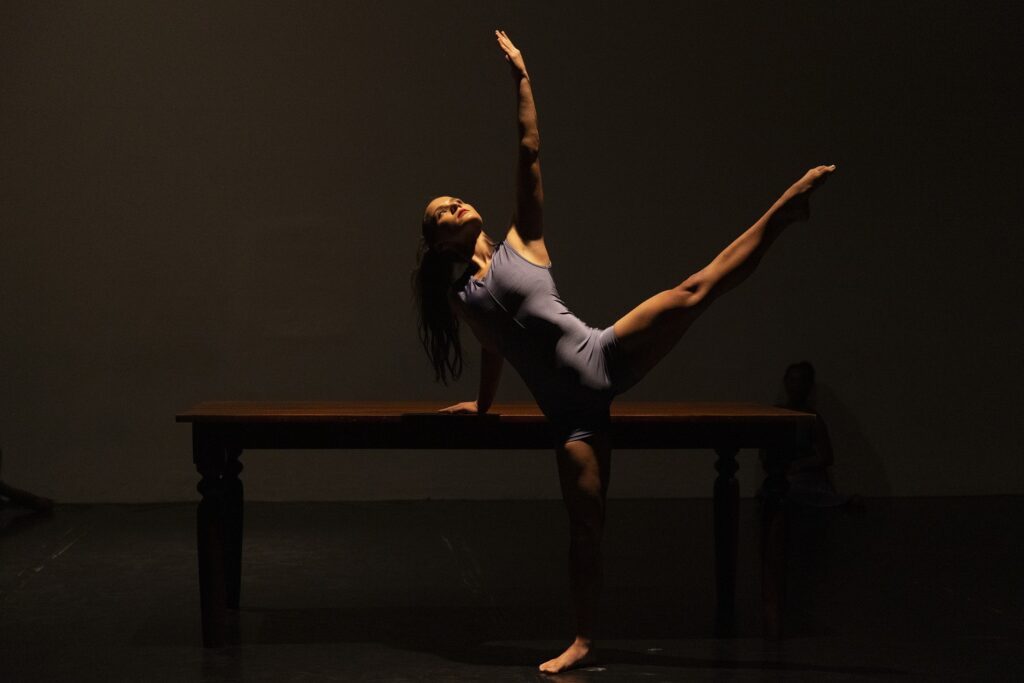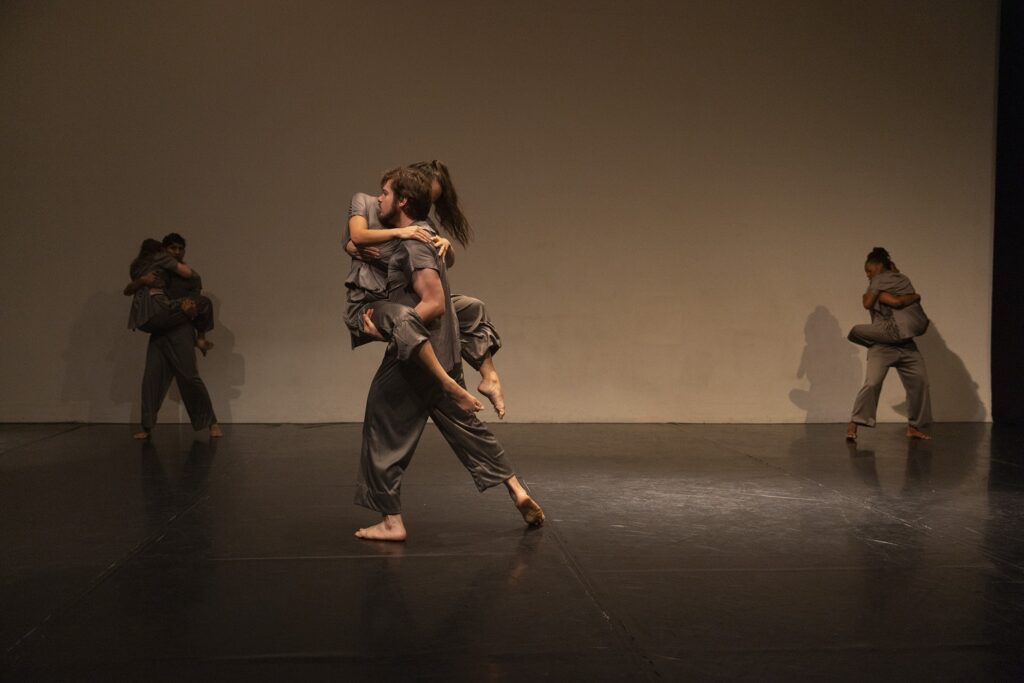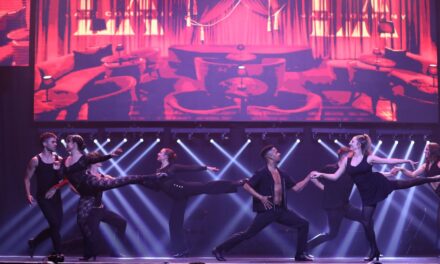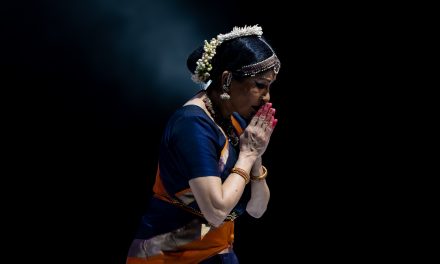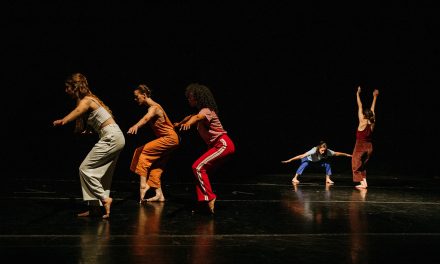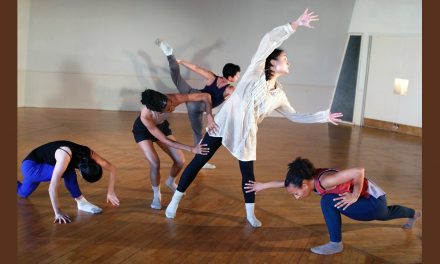On the evening of Sunday, June 22, 2025 at Brockus Project Studios, I enjoyed a program of works by BrockusRED and the end results of Deborah Brockus’ new MATCH Residency. As the hot day outside cooled down, things heated up in the studios – quite literally as the central air had decided to malfunction and spit out hot air on the day of the show. This performance was part of the second weekend of a three weekend series of shows; each program with a different variety of works. Some works were strongly envisioned but less rehearsed and other works were cleaner with less vivid inspiration, and it was overall an enjoyable evening.
BrockusRED presented four works, opening and closing each act of the show. The first work of the night, “Pascal,” performed by Denali Huff, Rebecca Lee, Jolyn Lambey, and Raven Smith, was explained by choreographer Deborah Brockus to be about aging and generations. The piece used a table as a prop, which added some nice levels and interesting transitions on and off for the dancers who utilized it. The table started in the corner and then was moved during a pause to the center but given that the floor space was only used by one dancer at a time, it felt like perhaps the table could have been in one spot the whole time to avoid the longer pause and visible set change by the dancers. While the work was clean, I felt that the music, recognizable piano tunes by Erik Satie, and dancing were too similar in their level and pace. The technically strong dancers, who later showed their strong emotional performance in other works, felt detached from this one. I wondered if because the dancers were younger that maybe it was harder for them to emotionally connect and commit to the topic of aging.
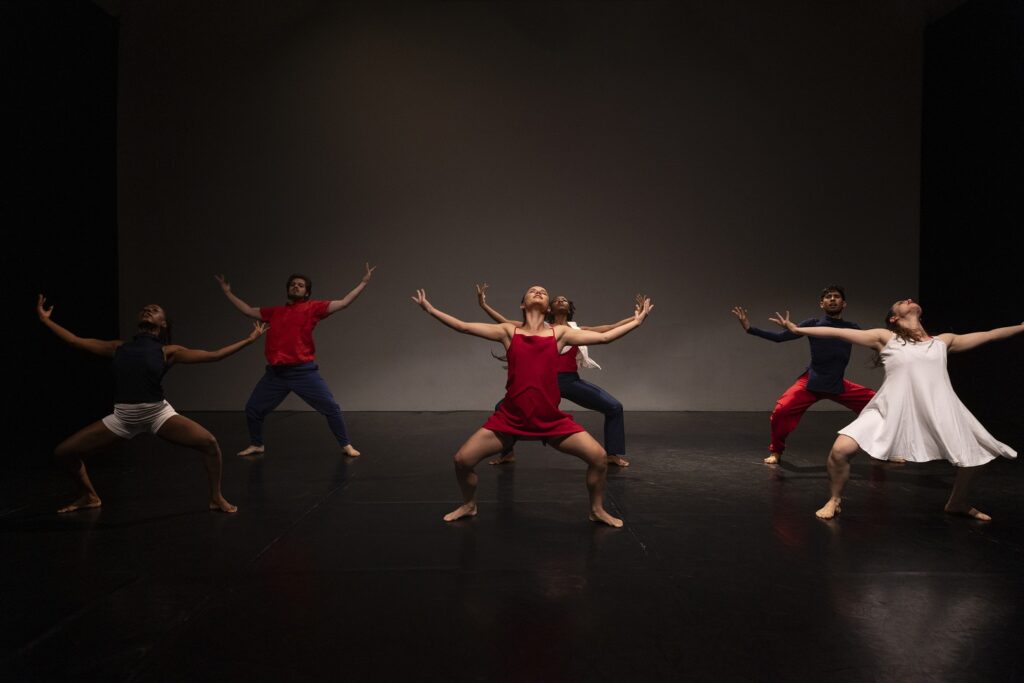
Brockus MATCH Residency – Brian Burns, Arturo Gonzalez, Denali Huff, Rebecca Lee, Jolyn Lambey, and Raven Smith in “American Dream” by Deborah Brockus – Photo by Don Hannah.
The next piece from BrockusRED, also choreographed by Deborah Brockus, was an excerpt of “American Dream,” originally choreographed in 1994, and it was impressive how well the message and piece felt current. Bryan Burns performed a powerful solo to a spoken word about the unfulfilled ideal of the American dream. I loved the contrast between strong technical feats and the punctuated spoken score. Burns had resilient facial expressions and as the piece progressed, he expressed the building tension as he scrambled and fell repeatedly to the floor. The second section, featuring Burns, along with Arturo Gonzalez, Denali Huff, Rebecca Lee, Jolyn Lambey, and Raven Smith, showed off strong Jazz technique to the apt music choice of Tracy Chapman’s “Talkin’ Bout a Revolution.” Again I appreciated how Brockus artfully used more technical skills than gestural movements in highlighting different layers of the music along with her timing choices. The determination and gusto of the dancers as they performed tirelessly, both in unison and in traveling pairs, showed passion and hope.
The final dance of the evening and Brockus’ third piece of choreography for her company was a new work called “Black Ice.” This piece also showed off her strong company’s technique and their ability to bring to life the uncertainty and uneasiness that Brockus was trying to portray. The strongest parts of the dance were when Brockus layered different things together; for example, a moment when four dancers performed in unison while two walked forward through them. Brockus also created strong partner work, using interesting leans and shapes where the dancers would wrap around each other. The music was dynamic though at times, the performance didn’t quite keep up with the powerful builds of the music. Brockus asked a lot of her dancers in terms of technique and stamina, and there were group sections that felt like they could use a bit more time to come fully together. With the topic and the chaotic layers of the music, I actually felt like some parts could have worked well if they were intentionally less together.
One of my favorite pieces of the evening, also danced by BrockusRED, was a staging of excerpts of Sean Greene’s “La Principessa Cane Magia” (The Magical Dog Princess). We witnessed “Act 2: The Family From Hell.” This utterly ridiculous, in the best possible way, made-up opera, as described by Greene, was a delight to watch. The dancers committed fully to their insane characters and succeeded with the spoken word demands of the piece. Greene’s duets were incredibly strong and showed huge range. In the duet between Arturo Gonzalez (Dad) and Raven Smith (the Saintly Mother) Gonzalez appeared oblivious to Smith as he effortlessly threw Smith about with her wrapped around him. Near the end of the duet between Denali Huff (the Daughter from Hell) and Jolyn Lambey (the Secret Lover), the choreography seemed to show separate movements that turned into incidental contact and then suddenly flourished into intertwining, passionate dancing. Rebecca Lee as the princess dog showed the humorous emotional journey of a dog that has become a princess. She could finally express love the way she wants to, sliding around on the floor, with her slinky movements punctuated by dog-like paws or excited twitches. Greene, despite the light topic, showed his skill as a choreographer in the way he wove subtle motifs throughout the work.
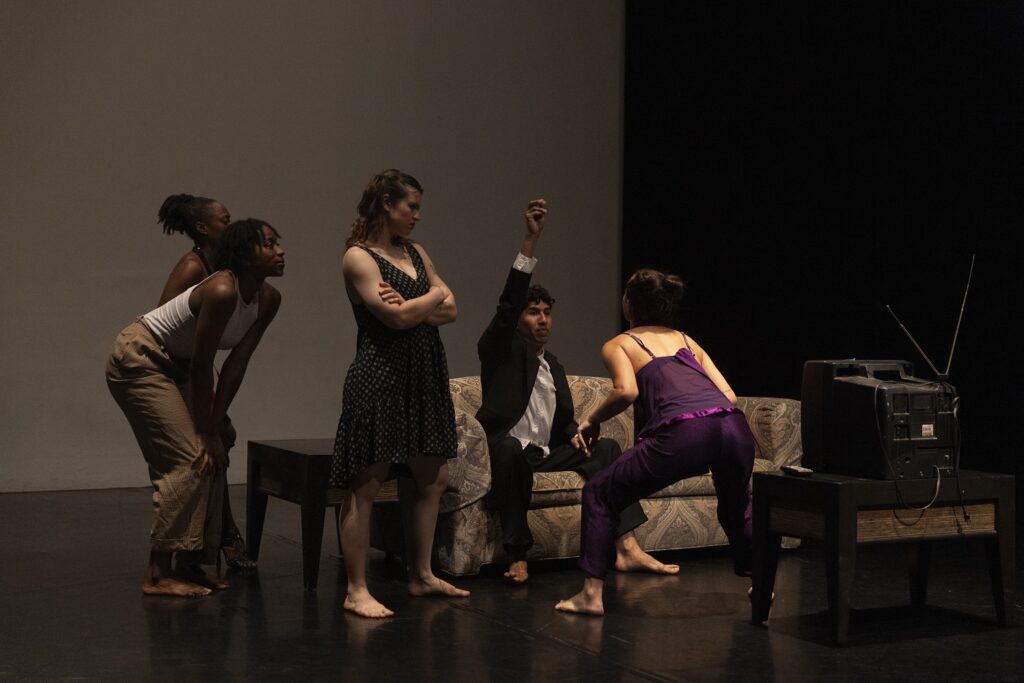
Brockus MATCH Residency – BrockusRED in Sean Greene’s “La Principessa Cane Magia” – Photo by Don Hannah.
Another highlight of the program was the powerful and succinct “And then, and then…” choreographed by Mia Moraru, and performed by Moraru and Kelsey Boyle. Inspired by a video Moraru had seen of dancers in Gaza dancing during airstrikes, we saw the two move to the sound of drones. The two started separately – Moraru slowly rolling up and hinging down as Boyle posed with quivering hands. In a unison section, the dancers showed strong, controlled anger and fear through their movements. Moraru used repetition and gesture well, alongside bigger and dynamic full body movements. As the dancers found each other in partnerwork, they slowly allowed themselves to soften and find solace, embracing desperately before separating to keep up the undulating waves of dancing. Their movements seemed initiated by the instinct to protect each other. At the end, they dropped to their knees together, huddled and braced for impact.
Rounding out the program were two works from Brockus’ new MATCH Residency which sought to connect selected choreographers with dancers who wanted to perform. All 45 dancers who showed up to audition were matched with at least one choreographer.
In the first act, Jill Gregory’s “what are we in service to?” was a strong work in progress. Gregory utilized a giant “coat” made of bed sheets as a unique prop and had extremely interesting visual ideas. She sought to show how we are stronger as a community when we rely on each other. As the piece started, the dancers were spread around the space moving independently. One dancer wearing the giant coat slowly walked across the stage and took everyone under the sheets, which stretched from one side of the stage to the other. As the dancers emerged and connected physically, I could see them progress from being physically connected but not necessarily connected on a deeper level to truly finding and seeing each other. One of the strongest moments of the piece was when one person slowly spun with her curved arms tracing the path of a propeller. As she rotated, the group gathered and slowly lifted her and then rotated her, continuing her movement pattern in the air. As they separated, spread out like they were at the start, they all played with the same arm shape, showing the connection they shared. The dancers sitting on the sheets spread like a giant picnic cloth, chatting lightly as the lights faded. Gregory had an excellent overall vision and strong movement ideas and I would love to see them developed further. The movements could have been more together at times but this was understandable given that the large cast was working together for the first time after limited rehearsals. For this viewer, things sometimes transitioned a bit suddenly and the piece might be strengthened by being extended so that some of the transitions could be fleshed out further.

Brockus MATCH Residency – Mia Moraru and Kelsey Boyle in Moraru’s “And then, and then” – Photo by Don Hannah.
The large cast was made up of John-Pierre Cardenas, Genevieve Fletcher, Zoe Foy, Sarah Gibson, Cassidy Kittredge, Jules Mara, Jared “Izy” Mathis, Jackie Nii, Theresa Reish, Victoria Renteria, Savannah Scott, Monika Sharma, Zoey Shockley, Rivka Villanueva, Sarah Witzman, and Stephanie Yates.
The MATCH piece in the second act, “Tending the Waters” choreographed by Charlotte Katherine Smith, was meant to be a moment to release and recharge, especially with the chaos in the world right now and featured a cast of ten dancers backed up by visuals projected onto the back wall. The video appeared to show a camera panning over drops of water on glass to the sounds of water running and a heartbeat. One dancer walked in while executing simple, soft gestures. Eventually her movements grew bigger while maintaining a sense of calm. Dressed in a palette of white, beige, and bronze, a line of dancers entered performing similar gestures. The soloist exited as the others continued forward before breaking apart and beginning to fill the space and occasionally interacted with one another. I enjoyed the layers of movements that were at different speeds – it reminded me of a body of water in constant motion, with some areas moving faster at times. One dancer executed a beautifully quiet solo of turns and legs as the rest moved back into their original gestural work. The way the dancer moved silently added to the meditative environment. The last image involved the dancers rotating in and out of a diagonal line, seeming to embody water again, like a tide ebbing and flowing, with little hops seeming to show drops or sprays of water popping up. The work was enjoyable and felt like the reset and moment of calm that Smith envisioned.
Throughout the evening, it was enjoyable seeing different artists express ways that art can react to real world events – Moraru’s “And then, and then…” forced us to witness and face reality; Brockus’ “American Dream” made a statement of hope and fight; Gregory’s “what are we in service to?” showed us that we are stronger as a community; Smith’s “Tending the Waters” gave us a moment to recharge; and Greene’s “La Principessa Cane Magia” brought levity and reminded me that sometimes absurdity is the best escape.
To learn more about Brockus Project Studios, please visit their website.
Written by Rachel Turner for LA Dance Chronicle.
Featured image: Brockus MATCH Residency – Jolyn Lambey and Arturo Gonzalez in Sean Greene’s “La Principessa Cane Magia” – Photo by Don Hannah.

